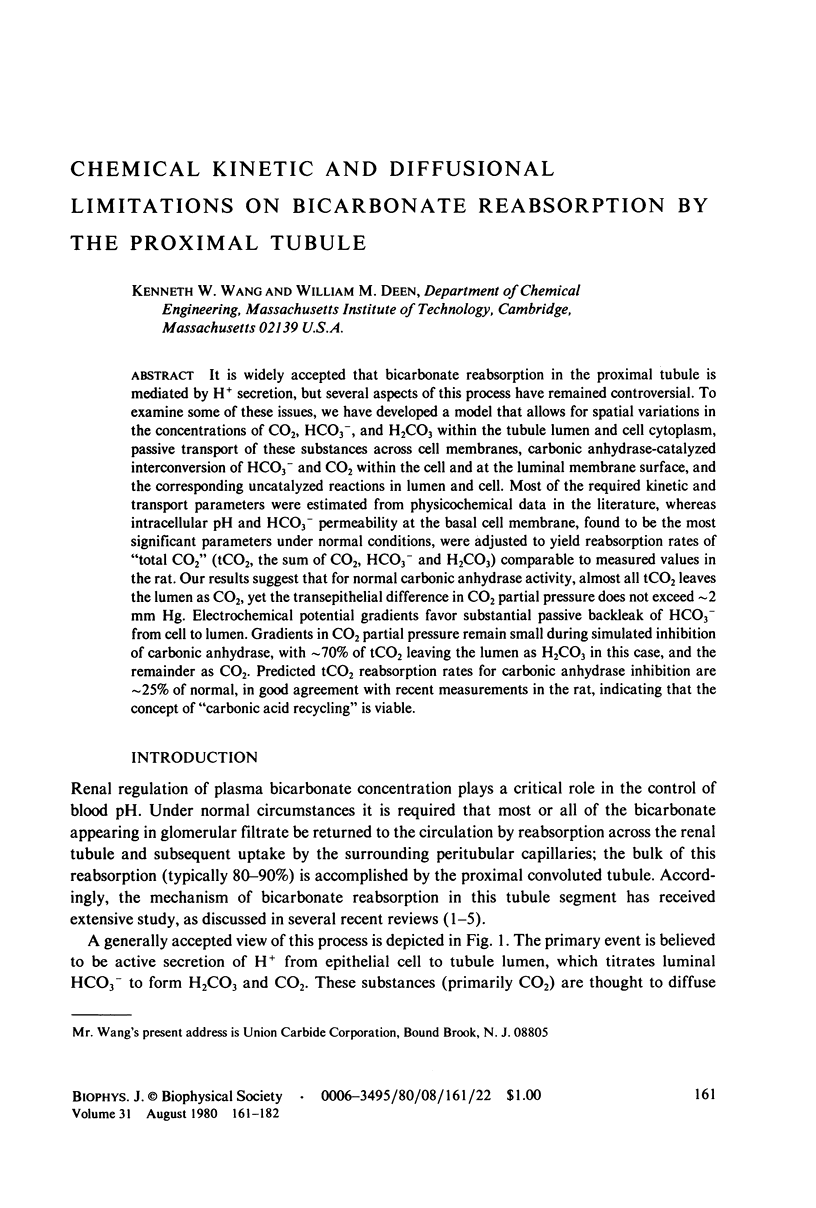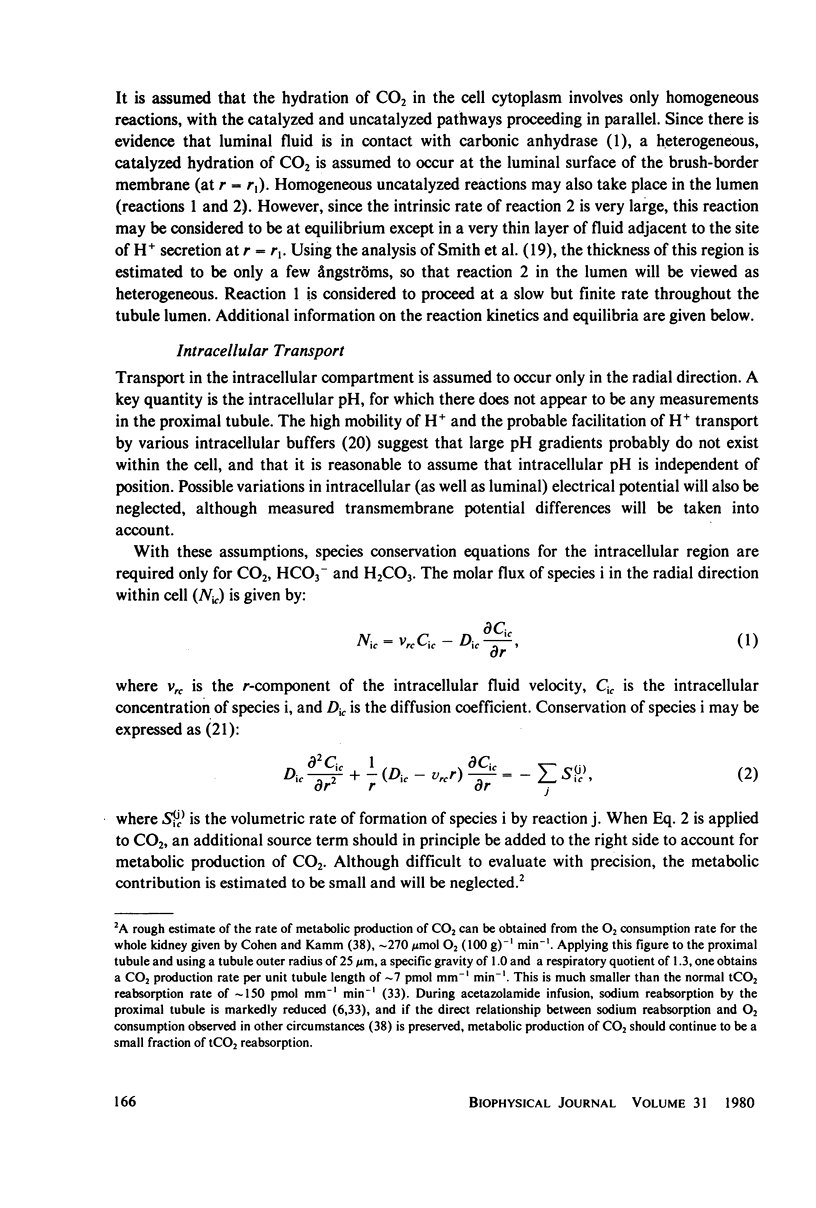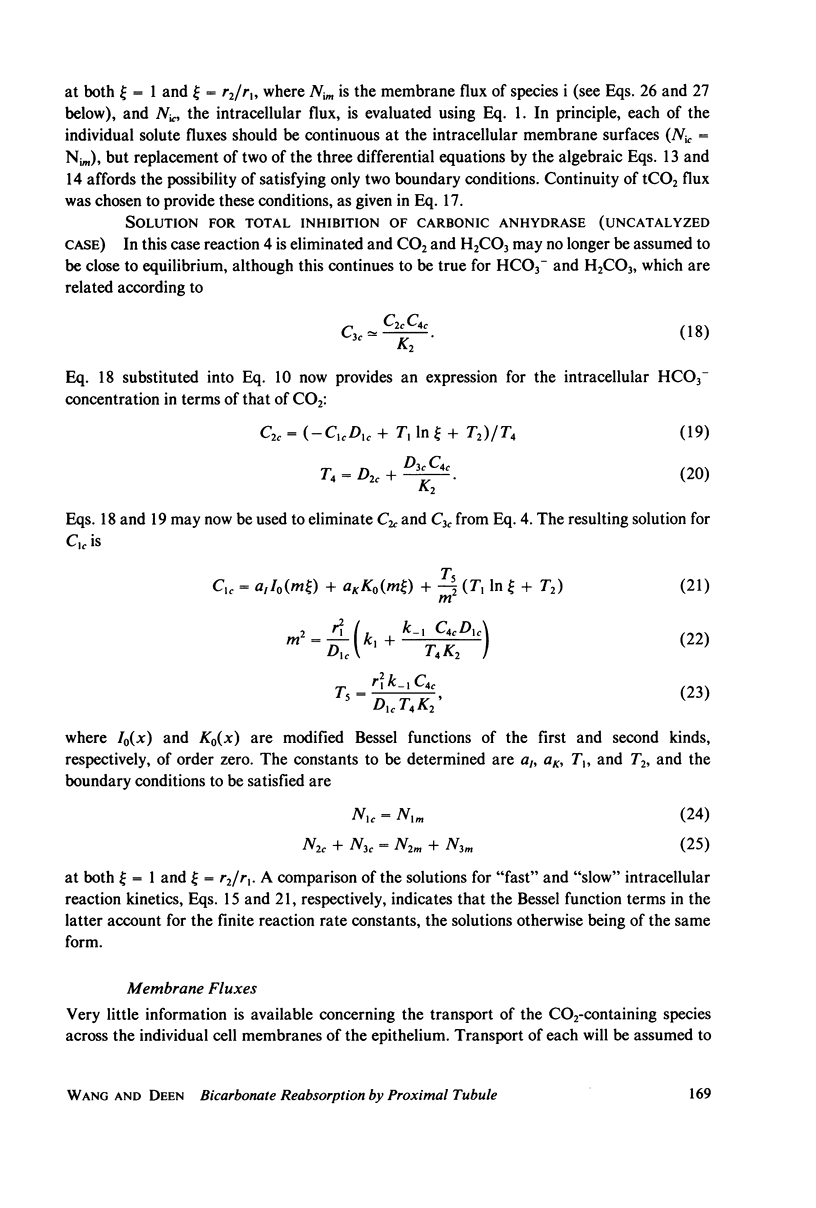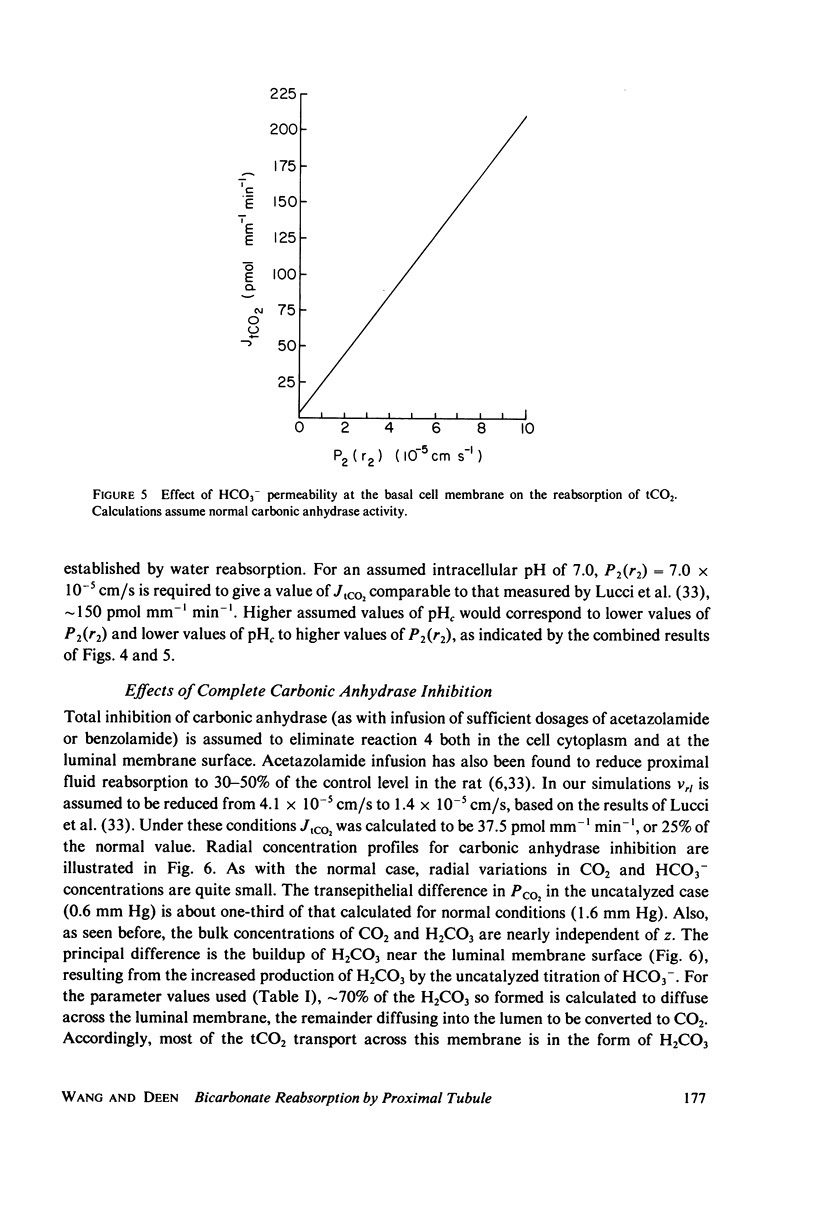Abstract
It is accepted that bicarbonate reabsorption in the proximal tubule is mediated by H+ secretion, but several aspects of this process have remained controversial. To examine some of these issues, we have developed a model that allows for spatial variations in the concentrations of CO2, HCO3-, and H2CO3 within the tubule lumen and cell cytoplasm, passive transport of these substances across cell membranes, carbonic anhydrase-catalyzed interconversion of HCO3- and CO2 within the cell and at the luminal membrane surface, and the corresponding uncatalyzed reactions in lumen and cell. Most of the required kinetic and transport parameters were estimated from physicochemical data in the literature, whereas intracellular pH and HCO3- permeability at the basal cell membrane, found to be the most significant parameters under normal conditions, were adjusted to yield reabsorption rates of "total CO2" (tCO2, the sum of CO2, HCO3- and H2CO3) comparable to measured values in the rat. Our results suggest that for normal carbonic anhydrase activity, almost all tCO2 leaves the lumen as CO2, yet the transepithelial differences in CO2 partial pressure does not exceed approximately 2 mm Hg. Electrochemical potential gradients favor substantial passive backleak of HCO3- from cell to lumen. Gradients in CO2 partial pressure remain small during simulated inhibition of carbonic anhydrase, with approximately 70% of tCO2 leaving the lumen as H2CO3 in this case, and the remainder as CO2. Predicted tCO2 reabsorption rates for carbonic anhydrase inhibition are approximately of normal, in good agreement with recent measurements in the rat, indicating that the concept of "carbonic acid recycling" is viable.
Full text
PDF





















Selected References
These references are in PubMed. This may not be the complete list of references from this article.
- Burg M., Green N. Bicarbonate transport by isolated perfused rabbit proximal convoluted tubules. Am J Physiol. 1977 Oct;233(4):F307–F314. doi: 10.1152/ajprenal.1977.233.4.F307. [DOI] [PubMed] [Google Scholar]
- Cassola A. C., Giebisch G., Malnic G. Mechansims and components of renal tubular acidification. J Physiol. 1977 Jun;267(3):601–624. doi: 10.1113/jphysiol.1977.sp011828. [DOI] [PMC free article] [PubMed] [Google Scholar]
- Cogan M. G., Maddox D. A., Warnock D. G., Lin E. T., Rector F. C., Jr Effect of acetazolamide on bicarbonate reabsorption in the proximal tubule of the rat. Am J Physiol. 1979 Dec;237(6):F447–F454. doi: 10.1152/ajprenal.1979.237.6.F447. [DOI] [PubMed] [Google Scholar]
- DuBose T. D., Jr, Pucacco L. R., Seldin D. W., Carter N. W. Direct determination of PCO2 in the rat renal cortex. J Clin Invest. 1978 Aug;62(2):338–348. doi: 10.1172/JCI109134. [DOI] [PMC free article] [PubMed] [Google Scholar]
- GIBBONS B. H., EDSALL J. T. RATE OF HYDRATION OF CARBON DIOXIDE AND DEHYDRATION OF CARBONIC ACID AT 25 DEGREES. J Biol Chem. 1963 Oct;238:3502–3507. [PubMed] [Google Scholar]
- Goldman D. E. POTENTIAL, IMPEDANCE, AND RECTIFICATION IN MEMBRANES. J Gen Physiol. 1943 Sep 20;27(1):37–60. doi: 10.1085/jgp.27.1.37. [DOI] [PMC free article] [PubMed] [Google Scholar]
- Gros G., Moll W. Facilitated diffusion of CO2 across albumin solutions. J Gen Physiol. 1974 Sep;64(3):356–371. doi: 10.1085/jgp.64.3.356. [DOI] [PMC free article] [PubMed] [Google Scholar]
- Gros G., Moll W., Hoppe H., Gros H. Proton transport by phosphate diffusion--a mechanism of facilitated CO2 transfer. J Gen Physiol. 1976 Jun;67(6):773–790. doi: 10.1085/jgp.67.6.773. [DOI] [PMC free article] [PubMed] [Google Scholar]
- Gutknecht J., Bisson M. A., Tosteson F. C. Diffusion of carbon dioxide through lipid bilayer membranes: effects of carbonic anhydrase, bicarbonate, and unstirred layers. J Gen Physiol. 1977 Jun;69(6):779–794. doi: 10.1085/jgp.69.6.779. [DOI] [PMC free article] [PubMed] [Google Scholar]
- KERNOHAN J. C., FORREST W. W., ROUGHTON F. J. The activity of concentrated solutions of carbonic anhydrase. Biochim Biophys Acta. 1963 Jan 8;67:31–41. doi: 10.1016/0006-3002(63)91794-3. [DOI] [PubMed] [Google Scholar]
- Karlmark B., Danielson B. G. Titratable acid, PCO2, bicarbonate and ammonium ions along the rat proximal tubule. Acta Physiol Scand. 1974 Jun;91(2):243–258. doi: 10.1111/j.1748-1716.1974.tb05681.x. [DOI] [PubMed] [Google Scholar]
- Kunau R. T., Jr The influence of the carbonic anhydrase inhibitor, benzolamide (CL-11,366), on the reabsorption of chloride, sodium, and bicarbonate in the proximal tubule of the rat. J Clin Invest. 1972 Feb;51(2):294–306. doi: 10.1172/JCI106814. [DOI] [PMC free article] [PubMed] [Google Scholar]
- Levine D. Z. Difficulties in the micropuncture evaluation of proximal renal bicarbonate reabsorption: an overview for the general reader. Can J Physiol Pharmacol. 1978 Jun;56(3):354–361. doi: 10.1139/y78-054. [DOI] [PubMed] [Google Scholar]
- Lucci M. S., Warnock D. G., Rector F. C., Jr Carbonic anhydrase-dependent bicarbonate reabsorption in the rat proximal tubule. Am J Physiol. 1979 Jan;236(1):F58–F65. doi: 10.1152/ajprenal.1979.236.1.F58. [DOI] [PubMed] [Google Scholar]
- Malnic G., Giebisch G. Symposium on acid-base homeostasis. Mechanism of renal hydrogenion secretion. Kidney Int. 1972 May;1(5):280–296. doi: 10.1038/ki.1972.41. [DOI] [PubMed] [Google Scholar]
- Maren T. H. Carbon dioxide equilibria in the kidney: the problems of elevated carbon dioxide tension, delayed dehydration, and disequilibrium pH. Kidney Int. 1978 Nov;14(5):395–405. doi: 10.1038/ki.1978.144. [DOI] [PubMed] [Google Scholar]
- Maren T. H. Carbonic anhydrase: chemistry, physiology, and inhibition. Physiol Rev. 1967 Oct;47(4):595–781. doi: 10.1152/physrev.1967.47.4.595. [DOI] [PubMed] [Google Scholar]
- Maren T. H. Chemistry of the renal reabsorption of bicarbonate. Can J Physiol Pharmacol. 1974 Dec;52(6):1041–1050. doi: 10.1139/y74-138. [DOI] [PubMed] [Google Scholar]
- Sohtell M. PCO2 of the proximal tubular fluid and the efferent arteriolar blood in the rat kidney. Acta Physiol Scand. 1979 Feb;105(2):137–145. doi: 10.1111/j.1748-1716.1979.tb06325.x. [DOI] [PubMed] [Google Scholar]
- Waddell W. J., Bates R. G. Intracellular pH. Physiol Rev. 1969 Apr;49(2):285–329. doi: 10.1152/physrev.1969.49.2.285. [DOI] [PubMed] [Google Scholar]
- Warnock D. G., Burg M. B. Urinary acidification: CO2 transport by the rabbit proximal straight tubule. Am J Physiol. 1977 Jan;232(1):F20–F25. doi: 10.1152/ajprenal.1977.232.1.F20. [DOI] [PubMed] [Google Scholar]
- Warnock D. G., Rector F. C., Jr Proton secretion by the kidney. Annu Rev Physiol. 1979;41:197–210. doi: 10.1146/annurev.ph.41.030179.001213. [DOI] [PubMed] [Google Scholar]
- Welling L. W., Welling D. J. Surface areas of brush border and lateral cell walls in the rabbit proximal nephron. Kidney Int. 1975 Dec;8(6):343–348. doi: 10.1038/ki.1975.125. [DOI] [PubMed] [Google Scholar]


